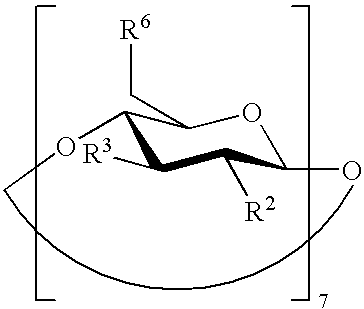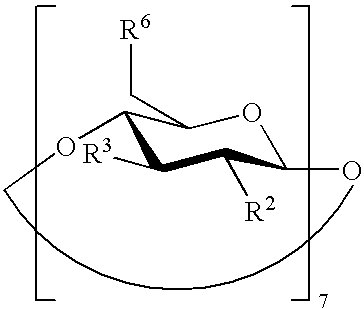Beta-cyclodextrin derivatives as antibacterial agents
a technology of betacyclodextrin and derivatives, which is applied in the field of betacyclodextrin derivatives as antibacterial agents, can solve the problems and achieve the effect of more difficult evolution of resistance to these antibiotics
- Summary
- Abstract
- Description
- Claims
- Application Information
AI Technical Summary
Benefits of technology
Problems solved by technology
Method used
Image
Examples
example 1
Bacterial Growth Standardization
[0033] One to three colonies of bacteria were picked from an Mueller-Hinton or Brain Heart infusion agar plate (depending on the bacterial strain) and transferred to 3 ml Mueller-Hinton broth or Brain Heart infusion media (depending on the bacterial strain). Bacteria were allowed to grow for 2-4 hours in an incubator at 37° C. Bacteria-inoculated media were dispersed in 0.9% saline to match McFarland standard density. 100 μl standardized inoculation was added to 20 ml media (dilution 1). 10 μl of the new dilution was added to 990 μl media and mixed (dilution 2). 10 μl of dilution 2 was spread on an agar plate and allowed to grow overnight. Colonies were then plated.
example 2
Bacterial Panel Testing
[0034] Test compound was diluted to 10 μg / ml in dimethylsulfoxide. Four μl of diluted test compound was loaded into column 2 of a 96 well NUNC microplate, as shown in Table 1 below. Four μl of Rifampicin antibiotic was loaded into row H, column 2.
TABLE 196 well NUNC microplate set-up, Concentration in μg / ml123456789101112A0200100502512.56.253.121.560.780.390.20B0200100502512.56.253.121.560.780.390.20C0200100502512.56.253.121.560.780.390.20D0200100502512.56.253.121.560.780.390.20E0200100502512.56.253.121.560.780.390.20F0200100502512.56.253.121.560.780.390.20G0200100502512.56.253.121.560.780.390.20H0200100502512.56.253.121.560.780.390.20rifampicin
[0035] All wells were then filled with 100 μl of inoculated media (dilution 1 from Example 1). A further 100 μl of the inoculated media was then added to column 2 and the contents are pipetted to thoroughly mix the contents. A full 100 μl was then transferred from column 2 and mixed into column 3. This process was co...
example 3
Potentiation of Clinically Used Antibiotics by Compounds vs. Clinical Isolates of Pseudomonas aeruginosa
[0036] Numerous pathogenic bacteria have developed a resistance to many clinically used antibiotics. Following the protocols described herein, various compounds were mixed with clinically used antibiotics to treat Pseudomonas aeruginosa (P. aeruginosa). The results are shown in Tables 3 and 4 below. These results demonstrate that compounds of the invention are able to potentiate the activity of known antibiotics.
TABLE 3Activity of known antibiotics alone or in combination with compoundsof the inventionTest Compounds(susceptible clinical isolate)Methicillin>100Methicillin + PP5027 25-12.5Methicillin + PP5114 25-12.5Methicillin + PP51356.25-3.12Methicillin + PP5140100-50 Penicillin V>100Penicillin V + PP502750-25Penicillin V + PP511450-25Penicillin V + PP5135 25-12.5Penicillin V + PP514050-25Vancomycin>100Vancomycin + PP502712.5-6.25Vancomycin + PP5114 25-12.5Vancomycin + PP5...
PUM
| Property | Measurement | Unit |
|---|---|---|
| resistance | aaaaa | aaaaa |
| evolutionary resistance | aaaaa | aaaaa |
| bacterial resistance | aaaaa | aaaaa |
Abstract
Description
Claims
Application Information
 Login to View More
Login to View More - R&D
- Intellectual Property
- Life Sciences
- Materials
- Tech Scout
- Unparalleled Data Quality
- Higher Quality Content
- 60% Fewer Hallucinations
Browse by: Latest US Patents, China's latest patents, Technical Efficacy Thesaurus, Application Domain, Technology Topic, Popular Technical Reports.
© 2025 PatSnap. All rights reserved.Legal|Privacy policy|Modern Slavery Act Transparency Statement|Sitemap|About US| Contact US: help@patsnap.com



